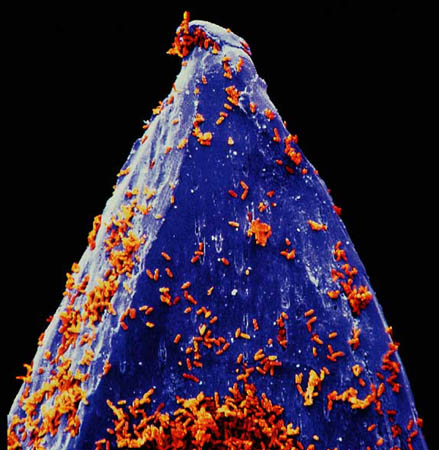
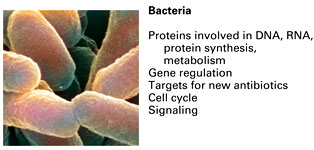
Model Organisms in Biological Research...
In its first-ever supplement the journal, The Scientist (June 2, 2003 V17), highlights some of the many species that have been used as model organisms in biological research, especially to big 8. The collection covers Escherichia coli, a common intestinal bacterium, that can cause diarrheal diseases; Saccharomyces cerevisiae and Schizosaccharomyces pombe, a pair of single-cell eukaryotes, both yeasts, but distant cousins, known for their roles in bread and beer production; Caenorhabditis elegans, the tiny, soil-dwelling worm; Drosophila melanogaster, the ubiquitous fruit fly; Danio rerio, known as the zebrafish to aquarium owners everywhere; Arabidopsis thaliana, the unprepossessing little weed, which models for the entire plant kingdom; and the once-humble house mouse, Mus musculus, now breeding a $200 million (US) per year business.
| 1. E. coli - The Scientist Article | ||
|
|
Despite their relative simplicity (bacterial genomes are about 0.1% the size of mammalian counterparts), bacteria continue to surprise researchers. Nearly 40% of the Escherichia coli genome consists of genes encoding proteins of unknown function. Recent evidence shows that some species cheat death, cannibalize their dead neighbors' DNA, and can survive a century in suspended animation. Bacteria's heyday is far from over. [bacteria on head of pin] |  |
| 2 & 3. yeast - The Scientist Article | ||
|
|
Much smaller than a white blood cell, never-the-less it has many of the cellular functions of higher species are present in unicellular yeast. Two species of yeast have been pressed into service as model organisms: S. cerevisiae and its distant cousin S. pombe. Each one has nearly 200 genes homologous to human genes involved in disease, with 23 for cancer alone. Used since Ancient Egypt, yeast has economic importance in beer and bread making. |
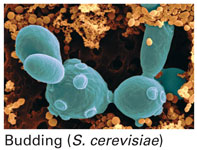 * * |
| 4. roundworms - The Scientist Article | ||
|
|
Caenorhabditis elegans is a nematode, a smooth-skinned worm with a long, unsegmented, cylindrical body tapered at both ends. Comprising about 1,000 cells, it is the most primitive animal to exhibit characteristics that are important in the study of human biology and disease. Though tiny and transparent, C. elegans contains a full set of differentiated tissues, including a nervous system with a "brain," which allows the study of behavior in a worm that is capable of learning. It is found worldwide in soil and rotting vegetation. |
|
| 5. fruit fly - The Scientist Article | ||
|
|
Drosophila melanogaster, the ever pesky fruit fly, is a classic organism used for the study of animal genetics. Introduced to lab research by Thomas Hunt Morgan in early 1900's it is ideal for making genetic crosses: short life cycle, ease of culture, and high fecundity. Mutant flies, with defects in any of several thousand genes, are now used for the study of genetics, development, and behavior topics. |
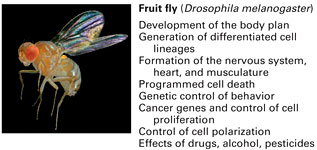 |
| 6. zebrafish - The Scientist Article | ||
|
|
Small, tropical zebrafish, native to southeast Asia, have become important to lab research in the last few years. Easy to care for, they breed prodigiously. External fertilization allows easy genetic manipulation and analysis, and the embryo is optically transparent. In addition, the availability of a vast storehouse of mutations means that this model will provide insights into developmental processes for years to come. |
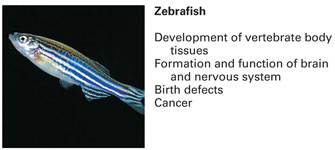 * * |
| 7. thale cress - The Scientist Article | ||
| Despite its weedy appearance, Arabidopsis thaliana, commonly known as thale cress or mouse-ear cress, is the undisputed model plant. Ease of cultivation, rapid life cycle, and high seed production are bolstered by small genome size and ease of transformation. As a result of evolutionary conservation, many of the fundamental advances using Arabidopsis are finding useful application in the improvement of crops such as maize, wheat, and rice. | 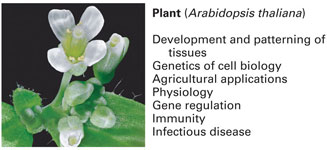 |
|
| 8. house mouse - The Scientist Article | ||
|
|
Naturally comfortable in fields, Mus musculus, for the last century, has been virtually indispensable in animal research labs. This animal now appears in all shapes and sizes, as researchers consistently produce new strains. Mouse production is a $200 million-a-year business, with transgenics accounting for a third of the new mice created. |
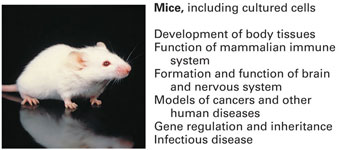 |
| 9. Viruses - | ||
|
|
Viruses cause a number of diseases in eukaryotes. In humans, smallpox, the common cold, chickenpox, influenza, shingles, herpes, polio, rabies, Ebola, hanta fever, and AIDS are examples of viral diseases. Even some types of cancer (cervical cancer) have been linked to viruses. Viruses can transfer genetic material between different species of host and are extensively used in genetic engineering. Viruses also carry out natural "genetic engineering": by incorporating some genetic material from its host and transferring it to a new host in a process known as transduction, and in some cases it may serve as a means of evolutionary change. |
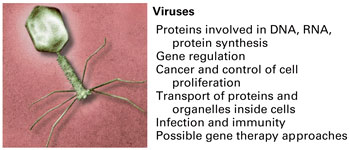 |